
Don's Victrola Page
When
I was about ten years old, my uncle gave me a record that he said belonged to my
mother when she was a young girl. This was something very different than
what I was accustomed to calling a "record". This thing was not
thin and flexible, and it couldn't even be played on a stereo! It was
large like an album, yet it only had one song on each side. When I took it
in my hands it was very heavy as if it were made of stone. Certainly, this
could not have music recorded on it! I think I was most intrigued to be
holding something that my mother had treasured when she was a child of my
age. I had to hear what sound it was that intrigued her as a child as much
as stereo had intrigued me! I took it home and tried to play in on my
phonograph, but the sound was too slow! I asked my mother why it sounded
so strange and she told me about "78's".  Sure enough, there was
a speed setting on my phonograph that I though was only there for kids to make
their records sound like chipmunk songs. The black RCA Victor label spun
wildly about, faster than my eyes could even follow it, yet it played at the
right speed! It was scratchy and sounded like a far-away radio
station just about to fade away. I listened intently as if it were the
last time I might be able to hear it before it disappeared forever. Sound
was traveling through time from a distance long before I was even born.
This concept was even more intriguing to me than was stereo, quadrophenia, or
sound coming from magnetic-coated cellophane tape!
Sure enough, there was
a speed setting on my phonograph that I though was only there for kids to make
their records sound like chipmunk songs. The black RCA Victor label spun
wildly about, faster than my eyes could even follow it, yet it played at the
right speed! It was scratchy and sounded like a far-away radio
station just about to fade away. I listened intently as if it were the
last time I might be able to hear it before it disappeared forever. Sound
was traveling through time from a distance long before I was even born.
This concept was even more intriguing to me than was stereo, quadrophenia, or
sound coming from magnetic-coated cellophane tape!
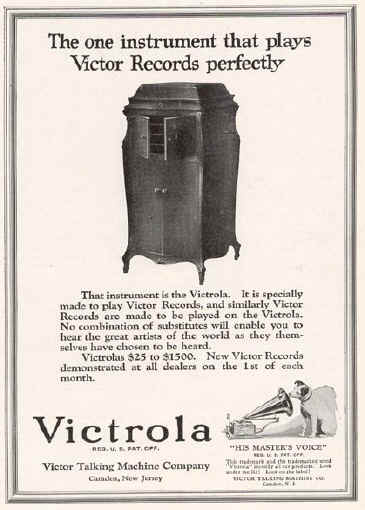
Over the next few months, I became
obsessed with learning all I could about the machines that played these types of
recordings. Late that summer, I saw an advertisement for an antique
Victrola with records for sale at a garage sale. I told my parents that I
had to have it and I begged them to take me there to buy it. My parents laughed, but I must have been persuasive enough to win them over. We went to
the bank to withdrawal my entire savings account, but it was not enough.
My parents knew how long and hard I had worked to accumulate that money, so they
know how serious I was about this purchase. They put up the difference to
buy the Victrola and we brought it home. It took my father, my uncle, and
my cousin to carry it up the stairs and into my bedroom where I proudly
displayed it and lovingly cared for it through the years while I was growing up.
My Victrola



My Victrola came with about a hundred records,
mostly Italian opera from the 1890's and early 1900's. My imagination took
me back in time with the help of these historic sounds. I
was inspired to learn as much as I could about the invention of the phonograph
and the history of the companies who manufactured them. As I grew older,
my collection of records also grew. I went to garage sales and flea
markets to find as many of these old "78's" as I could afford to
buy. I remember one antique store that I used to make my mother take me to
that had an entire attic FULL of vintage 78's. They were selling them for
ten cents apiece! Every week after I got my allowance we would go there
and buy as many as I could afford.....ten, fifteen, and once even twenty at a
time! Years later, when I started working and driving, I journeyed back
with a wallet full of money and an empty truck to load them all into.
Unfortunately, the proprietor told me that she had long since sold the lot of
records for a lump sum to someone to make room for other merchandise. From
time to time I still have dreams of finding an attic full of records of antique
phonograph records for ten cents each!
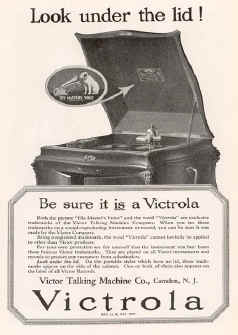
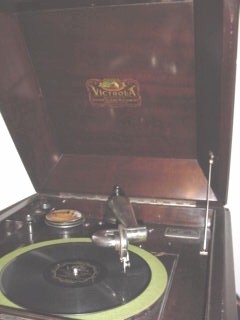
Yep! It's a Victrola!

Vintage Victrola Advertising

1900's

1910's




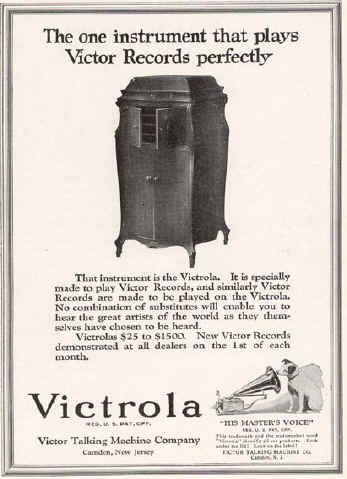




1920's



1930's

1940's

1950's
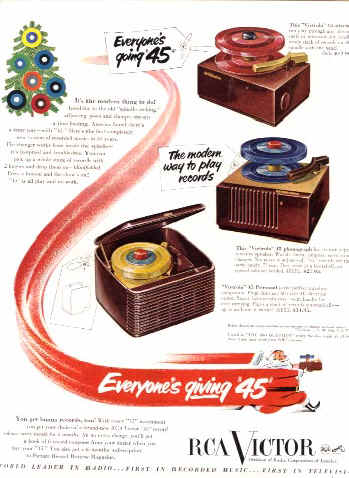
My visit to the RCA Victor Building
in Camden, NJ

In the summer of 1990, I had the opportunity to visit the site
of the former RCA / Victor Talking Machine corporate headquarters and
manufacturing facility in Camden, NJ. It was a great thrill for me to see
the actual factory building where my Victrola was built nearly a century
ago! We were on a family vacation to Pennsylvania Dutch Country, just west
of Philadelphia. I remember dragging my family across the Benjamin
Franklin Bridge that connects the city of Philadelphia, PA to the smaller city
of Camden, NJ on the other side of the Delaware River. I was very impressed by the architecture of the building. It is very
obvious that the style of the building was inspired by the lines and form of the
machines that were manufactured there. Ornate carvings above windows mimic
those on the leg and side panels of many of the upright Victrola models.
The centerpiece of the complex is the RCA tower. When the Radio
Corporation Of America took over operations of the Victor Talking Machine
Company in 1919, the building we see today was constructed.
I was very impressed by the architecture of the building. It is very
obvious that the style of the building was inspired by the lines and form of the
machines that were manufactured there. Ornate carvings above windows mimic
those on the leg and side panels of many of the upright Victrola models.
The centerpiece of the complex is the RCA tower. When the Radio
Corporation Of America took over operations of the Victor Talking Machine
Company in 1919, the building we see today was constructed.
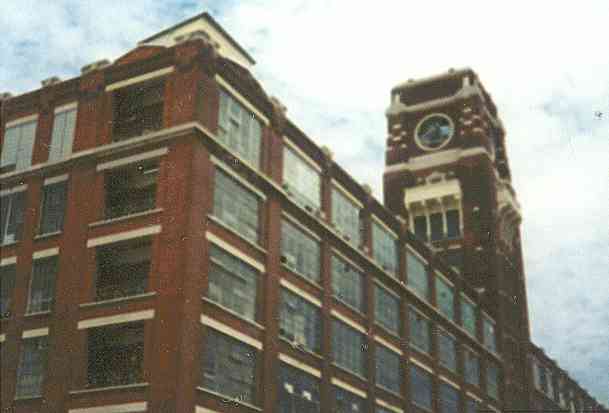 The
tower seems to represent strength and supremacy - a theme that ran throughout
RCA advertising into the 1920's. I couldn't help but notice that the tower
also bears a striking resemblance to an upright Victrola model with the lid and
doors closed! The most impressive feature of the tower is the giant round
(nearly sixteen feet in diameter) stained glass window replicas of the
RCA-Nipper logo that proudly advertised the company product to everyone within
visual distance of the tower.
The
tower seems to represent strength and supremacy - a theme that ran throughout
RCA advertising into the 1920's. I couldn't help but notice that the tower
also bears a striking resemblance to an upright Victrola model with the lid and
doors closed! The most impressive feature of the tower is the giant round
(nearly sixteen feet in diameter) stained glass window replicas of the
RCA-Nipper logo that proudly advertised the company product to everyone within
visual distance of the tower.

How "supreme" the RCA Victor tower must have
looked in the evenings - illuminated along the riverfront skyline of the 1920's,
when many homes were still without electricity and any electrical appliance was
still a novelty. Perhaps it reminded many passerby's to visit their
neighborhood Victrola dealer to purchase the latest model!

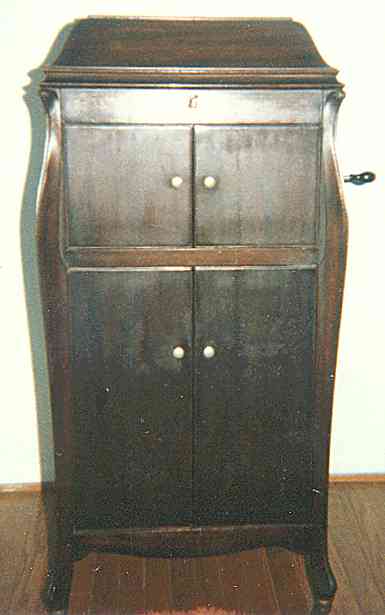
The factory is no longer used by RCA. It
was sold many years ago. Since then, the area had started to
deteriorate. However, new life is now being breathed into the entire
riverfront area of Camden. The area is being transformed into an upscale
tourist area and shopping district, and the old RCA Victor building is being
renovated into luxury condominiums.

3-D Stereo View of the Victor building facing westward toward the river and Philadelphia.
More to come soon....
